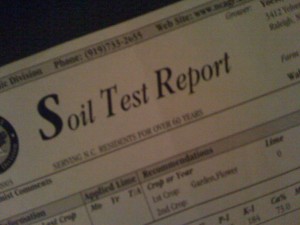North Carolina soils tend to be acidic and low in nutrients. It’s a good idea to have your soil tested. In doing so, you’ll learn what amendments are needed to optimize the particular plants you are growing or want to grow.
Various plants have specific soil pH preferences. Blueberries will perform better at a low pH, around 4.8. Whereas, turfgrass, such as tall fescue, will be tolerate a while range of pH conditions, but it will be the most productive when the soil pH is between 5.8 to 6.5.
The pH reading is a logarithmic scale from 0 to 14. Acid (0) is at one end of the scale and basic (14) is at the other end. Acid and base are two extremes. Pure water, registering at a pH 7, is neither acidic or basic, and is considered neutral. Mixing acids and bases can cancel out or neutralize their extreme effects. Click Here to read about Weeping Bald Cypress, Taxodium distichum ‘Cascade Falls’
A soil with a pH lower than 7.0 is an acidic soil and one with a pH higher than 7.0 is considered to be alkaline. A pH of 7.0 is neutral.
Because the scale is logarithmic, a point up or down the scale is dramatic. Each whole pH point is a ten times difference. For example, a pH of 6 is ten times more acidic than pH 7.
The pH of your soil can be adjusted by adding a neutralizing chemical depending if your soil is too acidic or too basic for your plant’s needs. Since we tend to have acidic soil in North Carolina, adding lime is a common pH correction. The test results will also recommend the correct amount of fertilizer based on what may be necessary for your soil to be productive.

The North Carolina Department of Agricultural & Customer Service (NCDA&CS Agronomic Division) performs soil tests free of charge for all North Carolina residents.
For my home garden, I have my soil tested about every 3 years. An annual test is not necessary for most areas.
The soil test will measure the following:
Acidity levels and pH
Major nutrients–phosphorus, potassium, calcium, magnesium, and sulfur
Micronutrients–copper, manganese, and zinc
Sodium
Soil classification
Percent base saturation
Percent humid matter
Cation exchange capacity
Weight-to-volume ratio
Site-specific fertilizer and lime recommendations will be determined from these data
For the best results, good sample collection will be necessary. Taking samplings from multiple sites in a bed or lawn area will be needed. Each area sample should consist of 15 – 20 individual grabs. Thoroughly mix these grabs to generate one representative sample for each area you need tested.
COLLECTING SOIL SAMPLES
Gather what’s needed–either a soil probe, shovel, or hand trowel.
Plastic container to hold the collected soil.
Sample box from the NCDA&CS. Please note: sample boxes are not available by mail. They can be picked at your county Cooperative Extension office or at the Agronomic Division office in Raleigh.
Sample information form. This can be picked up with the boxes.
Pen or pencil.
HOW-TO
Select the area to be sampled. It can be a flower bed or border, vegetable garden, blueberry patch, lawn, or any other discreet garden area.
Fill in information. The sample boxes comes flat, and forms a cube. It’s easier to write on the box while it’s still flat, so fill in all information before forming a box. Identify the sample area with a name you can easily decode when the results are returned. Veggies, roses, blueberries, front lawn, etc.
Regardless of your sample collection tool–shovel, trowel, or soil probe–grab some soil 6-8 inches deep, selecting about a quarter inch thick piece of dirt from the middle of the grab.
Place in the plastic container. Repeat this collection around the garden area for a representative sample. Ideally 15 – 10 grabs will make up a sample for the best results.
Mix the grabs to create one sample for testing. Fill the box up to the red line with the sample. Secure the top. Repeat this procedure for each area you want tested.
Fill out the sample information form, and include with your boxed sample(s). When filling out the form, use the same sample id used on the box–veggie, lawn, etc. This becomes important because the lab will be able to be very specific on your needs based on what you are growing. Also add the crop code; for most residential gardeners, the heading is Home Lawn and Garden.
More to read: Where to Find the Freshest Blooms for Delivery

